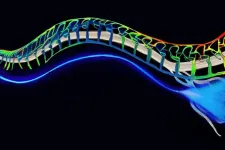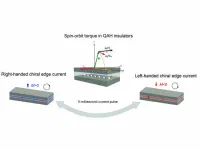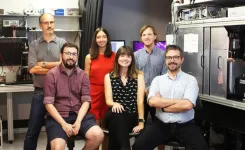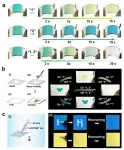(Press-News.org) HOUSTON ― Researchers at The University of Texas MD Anderson Cancer Center have discovered that lactate-producing intratumoral bacteria drives resistance to radiation therapy, suggesting that lactic acid-producing bacteria present in various cancers may serve as novel therapeutic targets.
The study, published today in Cancer Cell, reported that a particular bacterial species, Lactobacillus iners (L. iners), caused cancer cells to respond to radiation by rewiring metabolic signaling pathways to resist treatment. The researchers also found that L. iners was associated with poorer clinical outcomes in patients with cervical cancer.
“These lactic acid-producing bacteria are seemingly responsible for changing signaling pathways by priming cancer cells to use lactate instead of glucose to fuel growth and proliferation from oxidative stress following radiation therapy,” said corresponding author Lauren Colbert, M.D., assistant professor of Radiation Oncology. “This is potentially paradigm shifting, and we currently are working on novel approaches to target these specific intratumoral bacteria. We are hopeful that these efforts will lead us to approaches that can benefit patients across several types of cancer.”
Cervical cancer is a human papillomavirus (HPV)-related cancer that originates in the same way and is similar microscopically and genomically to anal and head and neck cancer. These types of cancers are commonly treated with different amounts of radiation. Cervical cancers often respond well to treatment, but some patients develop resistance, leading Colbert and her colleagues to examine the role of the tumor microbiome in driving differential responses. Researchers used microbiome sequencing, targeting bacterial cultures and in vitro models to study the tumor microbiome in this context.
Cervical cancer offers an opportunity for easier repeated tumor microbiome sampling, allowing the researchers to perform large-scale sequencing analyses and targeted culture of tumor-resident bacteria from 101 patients with cervical cancer undergoing chemoradiation between September 2015 and March 2022.
They discovered that L. iners was associated with poor response to radiation and with decreased recurrence-free survival (RFS) and overall survival (OS), even when accounting for known clinical risk factors, gut microbiome factors and immune environment factors in the tumor and in patients’ blood. This led the researchers to also perform targeted culture of this specific bacteria from patient samples.
L. iners is part of a group of fermenting bacteria that produce lactic acid as a metabolic end product. In this study, the researchers found that cancer-derived L. iners within tumors generate L-lactate, which cancer cells use instead of glucose to fuel metabolic cycles and to combat oxidative stress that occurs after radiation. Tumor lactate and lactate dehydrogenase (LDH) expression are already associated with aggressive tumor growth and poor survival across many cancer types.
The researchers, co-led by Ann Klopp, M.D., Ph.D., professor of Radiation Oncology, were able to induce treatment resistance by introducing lactate-producing L. iners to cancer cells in vitro, resulting in the rewiring of the tumor cell metabolism to use that increased lactate.
The results also revealed that L. iners have functions inside of tumors that are not present in healthy patients, suggesting that some changes in these bacteria themselves may occur prior to cancer development.
While this study focused on L. iners, the researchers observed a strong association between other tumor-associated lactic acid-producing bacteria and poor survival across multiple cancers, noting that 40% of species are associated with RFS in subsets of lung, colorectal, skin and head and neck cancers.
Colbert and colleagues currently are developing novel approaches to specifically target these bacteria inside tumors, including topical applications to deliver anti-cancer drugs and improve patient outcomes for various cancer types.
This study was funded in part by MD Anderson, including support from the HPV-Related Cancers Moon Shot® and other internal grants, as well as the Radiological Society of North America, the National Institutes of Health/National Cancer Institute (U54CA096300-19, P30CA16672), and the Cancer Prevention and Research Institute of Texas (CPRIT) (RP180734). A full list of co-authors and disclosures can be found here.
- 30 -
END
While the overall incidence and death rates from cervical cancer have dropped in the U.S., the opposite has been occurring in Appalachian Kentucky – a steady increase. The death rate from cervical cancer in Appalachian Kentucky is now twice that of the national rate.
A team of cancer population scientists from MUSC Hollings Cancer Center and the University of Kentucky Markey Cancer Center documented the increase through investigation of county-level data from 2000 through 2019. Their findings are published this month in JAMA Network Open.
“The rapidly growing disparities that we're ...
Study suggests that adhering to a Mediterranean diet may alleviate or prevent posttraumatic stress disorder (PTSD) symptoms
The human gut microbiome has a significant impact on our health. Research has shown that it can influence the development and response of emotions, but the relationship between posttraumatic stress disorder (PTSD) and the gut microbiome has been unexplored. PTSD is a fear-based mental health disorder that develops in some individuals who experience a disturbing and horrifying situation involving severe injury, actual or threat of death, or violence. A new study by investigators from Brigham and Women’s Hospital, a founding member of the Mass General Brigham healthcare ...
About The Study: The findings of this study that involved the use of data from Hong Kong and Singapore suggest that trust in health authorities was fundamental to overcoming COVID-19 vaccine hesitancy. As such, engendering trust in health care professionals, experts, and public health agencies should be incorporated into pandemic preparedness and response.
Authors: Michael Y. Ni, M.D., of the University of Hong Kong, is the corresponding author.
To access the embargoed study: Visit our For The Media website at this link https://media.jamanetwork.com/
(doi:10.1001/jamanetworkopen.2023.37909)
Editor’s Note: Please see the article ...
About The Study: In this study of 394 individuals, females with a family history of mood disorders were prone to weight gain starting around puberty and predating mood disorder onset. Early interventions aiming to prevent adverse mental and physical outcomes in this vulnerable group need to start in childhood.
Authors: Rudolf Uher, M.D., Ph.D., of Dalhousie University in Halifax, Nova Scotia, Canada, is the corresponding author.
To access the embargoed study: Visit our For The Media website at this link https://media.jamanetwork.com/
(doi:10.1001/jamanetworkopen.2023.38540)
Editor’s ...
Scientists have a new tool to precisely illuminate the roots of nerve pain.
Engineers at MIT have developed soft and implantable fibers that can deliver light to major nerves through the body. When these nerves are genetically manipulated to respond to light, the fibers can send pulses of light to the nerves to inhibit pain. The optical fibers are flexible and stretch with the body.
The new fibers are meant as an experimental tool that can be used by scientists to explore the causes and potential treatments for peripheral nerve disorders in animal models. ...
UNIVERSITY PARK, Pa. — A new electrical method to conveniently change the direction of electron flow in some quantum materials could have implications for the development of next-generation electronic devices and quantum computers. A team of researchers from Penn State developed and demonstrated the method in materials that exhibit the quantum anomalous Hall (QAH) effect — a phenomenon in which the flow of electrons along the edge of a material does not lose energy. The team described the work in a paper appearing today (Oct. 19) in the journal Nature ...
Touch plays a fundamental role in our physical, emotional, and social well-being. From a primary way of conveying emotions to sensory integration, it is crucial for the complex growth of cognitive, emotional, social, and behavioral abilities especially during the early development of infants and children. Touch allows us to build connections with others, eases pain and stress, and helps us to understand the world around us giving crucial information such as the texture, temperature, and shape of objects.
When sensing any stimuli, such as when the body is being touched, the mechanical signals are transformed into biological responses ...
A breakthrough development in photonic-electronic hardware could significantly boost processing power for AI and machine learning applications.
The approach uses multiple radio frequencies to encode data, enabling multiple calculations to be carried out in parallel.
The method shows promise for outperforming state-of-the-art electronic processors, with further enhancements possible.
In a paper published today in Nature Photonics, researchers from the University of Oxford, along with collaborators from the Universities of Muenster, Heidelberg, and Exeter, report on their development ...
In recent years, self-powered electrochromic (EC) devices have shown significant potential in various fields such as optoelectronics, sensors, and security systems. These self-powered EC systems, capable of reversible color switching without external power sources, have garnered considerable interest for next-generation electronic devices. However, this field is still in its infancy, with several unresolved challenges, including monochromatic displays, limited cycle durability, and the use of aqueous electrolytes. All these limitations have become ...
Global coastal adaptations are ‘incremental in scale’, short-sighted and inadequate to address the root causes of vulnerability to climate change, according to an international team of researchers.
The 17 experts, including Prof Robert Nicholls, Professor of Climate Adaptation at the University of East Anglia (UEA), have contributed to the paper, ‘Status of global coastal adaptation’, which is published today in Nature Climate Change.
Prof Nicholls said: “Recent analyses conclude that despite adaptation undertaken in all regions and sectors, global action remains incremental in scale: policies and projects ...






